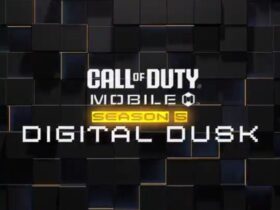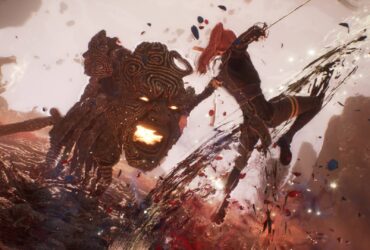The latest entry in localized nuclear post-apocalypses is coming with a distinctly British twist. Atomfall bases itself around an alternate history following an oft-overlooked disaster called the Windscale Incident.
Game Rant spoke with Head of Design Ben Fisher exploring Atomfall‘s connection to the real world’s first serious nuclear disaster.

Related
Atomfall: What Exactly Happened During the Real Windscale Disaster?
Atomfall is based on a harrowing real life incident that occurred in England, and fans may want to know more about the history behind it.
How the Windscale Incident Informed Atomfall
On October 10, 1957, a fire broke out at Unit 1 in the Windscale Nuclear Site in Cumberland on England’s northwest coast. The disaster was rated a 5 out of 7 on the International Nuclear Events Scale, resulting in nearly 250 cases of cancer, around 100 of which were fatal. It was a disaster with regional consequences in the real world, but in the world of Atomfall, those consequences were far worse.
Q: Let’s go back to day one. What was the initial pitch of the game and what attracted you to a fictional aftermath of the Windscale incident?
A: Our CEO, Jason Kingsley, noticed that there are many “nuclear quarantine” games (it’s like a micro-genre to itself) but none based around the world’s first major nuclear disaster, the Windscale Incident. Rebellion is usually attracted to broad, pulpy themes with a British slant to them, so it seemed like a starting point with a lot of potential.
Alongside this, Jason has always been fascinated by historical flashpoints; those pivotal moments that have the power to shape history. So, the Windscale Incident serves as a moment for us to jump away from history and in a sense explore a ‘what if’ timeline influenced by ‘50s sci-fi and British folklore.
Q: How familiar should players be with the Windscale incident?
A: You don’t need to know the background of the Windscale Incident because Atomfall is a fictionalized story set in its aftermath. Interestingly though, the Windscale Incident is often overlooked in British history because the government of the time was keen to downplay its seriousness and so not many people know much about what actually happened. But the game’s introduction will give you some basic information and then allow you to uncover more as you play.
Q: Can you detail the research process into the Windscale Incident? Is the alternate history of Atomfall fully focused on this event and location, or are there far-reaching world consequences? What’s the scope of this alternate history?
A: Atomfall plays out within the quarantine zone, an area that was sealed off by the government following the Windscale Incident. Both the outside world and those trapped inside the quarantine zone have had little contact with each other since the disaster occurred 5 years ago. A big part of the game is about the effect this isolation has had on those inside the quarantine zone, so we really wanted to keep things focused on this epicenter.
Life outside the quarantine zone remains a mystery to those inside it as no one has been outside since the disaster. This sense of tension, ambiguity, and trying to make do in the face of a vast unknown threat was a storytelling theme found in 1950s/1960s Britain, and it fit perfectly with our fiction.
Q: For those familiar and unfamiliar, what has changed the most in Atomfall from the real world around the Windscale Incident?
A: In our fictionalized version of events, we’ve used the incident as a jumping-off point to incorporate genres like science fiction through a what-if lens. Parts of the world will be instantly familiar, as we have used the real-world location as inspiration for a kind of “theme park” version of Cumbria that exaggerates the iconic details of rural Northern England–for example, the iconic red phone boxes.
The pressure of survival has also meant that factions have formed, and gangs of bandits roam the land. Whether you choose to encounter those is completely up to you, but if you choose to then you need to be prepared.
Without wanting to spoil anything, players will encounter some enemies and characters that have become… changed… by our version of the Windscale Incident, and been gifted unique traits and abilities…
Q: Alongside science fiction, you’ve also cited folk horror and the Cold War as influences on Atomfall. Can you discuss these and how they manifest in the game a little bit?
A: When we were finding the right “voice” for Atomfall, we really started to build up momentum when we looked back to the storytelling style of 1950s/’60s/’70s Britain–and there really wasn’t a clear division between genres at the time, because the genres were still forming. So, we looked for patterns and noticed that folk horror and cold war fiction have a few traits in common. They are usually about an uneasy “peace” that has formed, that sits on top of a bedrock of secrets and lies, and that uncovering the truth is dangerous and painful. They are both thematically about the tension between different organizations of belief and culture–tradition vs modernity, urban vs rural, eastern bloc vs western bloc, and so on.
This manifests in-game in several ways. First and most obviously, we evoke a lot of the tropes of folk horror and cold war fiction (alongside period sci-fi) to build the right atmosphere. The situations the player finds in the game world are also presented as morally ambiguous, no clear “good guy” and “bad guy,” but a lot of people making questionable decisions in difficult circumstances. Additionally, the characters the player finds in the game may well be misleading or manipulating you one way or another, so you have to keep your guard up and remain observant.
To say anything more specific would be a spoiler, so I won’t!
[END]

Survival
Action
Adventure
- Released
-
March 27, 2025
- ESRB
-
Teen // Blood, Language, Violence











Leave a Reply